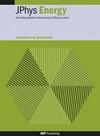表征钙钛矿太阳能电池中移动离子空位的贝叶斯参数估计
IF 6.3
3区 材料科学
Q1 ENERGY & FUELS
引用次数: 0
摘要
为了克服钙钛矿太阳能电池时间稳定性差的挑战,需要允许制造和表征快速迭代的方法,以便积极追求最佳的器件性能和稳定性。目前,确定性能不佳的原因既复杂又耗时,因此设备制造的优化本身就很慢。在这里,我们提出了一种\emph{仅}从室温电流-电压(J-V)测量中计算移动卤化物离子参数的计算设备表征方法,在基本计算资源上需要$\sim 2$小时的计算。利用我们的方法,器件的物理参数可以从实验J-V测量反向建模。在漂移-扩散模型中,漂移-扩散耦合偏微分方程组不能显式地反演,因此需要一种方法来反演漂移-扩散模拟。我们展示了贝叶斯参数估计(BPE)与漂移扩散钙钛矿太阳能电池模型的耦合如何确定器件参数对J-V特性测量的性能的影响程度。我们的方法是通过调查在何种程度上的设备性能受到移动卤化物离子的影响,为特定的制造设备证明。发现离子空位密度$N_0$和扩散系数$D_I$对模拟和制造的器件都有精确的表征。这一结果打开了通过找出在细胞降解时哪些参数最影响器件J-V曲线来精确定位降解起源的可能性。本文章由计算机程序翻译,如有差异,请以英文原文为准。
Bayesian parameter estimation for characterising mobile ion vacancies in perovskite solar cells
Abstract To overcome the challenges associated with poor temporal stability of perovskite solar cells, methods are required that allow for fast iteration of fabrication and characterisation, such that optimal device performance and stability may be actively pursued. Currently, establishing the causes of underperformance is both complex and time-consuming, and optimisation of device fabrication thus inherently slow. Here, we present a means of computational device characterisation of mobile halide ion parameters from room temperature current-voltage (J-V) measurements \emph{only}, requiring $\sim 2$ hours of computation on basic computing resources. With our approach, the physical parameters of the device may be reverse modelled from experimental J-V measurements. In a drift-diffusion model, the set of coupled drift-diffusion partial differential equations cannot be inverted explicitly, so a method for inverting the drift-diffusion simulation is required. We show how Bayesian Parameter Estimation (BPE) coupled with a drift-diffusion perovskite solar cell model can determine the extent to which device parameters affect performance measured by J-V characteristics. Our method is demonstrated by investigating the extent to which device performance is influenced by mobile halide ions for a specific fabricated device. The ion vacancy density $N_0$ and diffusion coefficient $D_I$ were found to be precisely characterised for both simulated and fabricated devices. This result opens up the possibility of pinpointing origins of degradation by finding which parameters most influence device J-V curves as the cell degrades.
求助全文
通过发布文献求助,成功后即可免费获取论文全文。
去求助
来源期刊

Journal of Physics-Energy
Multiple-
CiteScore
10.90
自引率
1.40%
发文量
58
期刊介绍:
The Journal of Physics-Energy is an interdisciplinary and fully open-access publication dedicated to setting the agenda for the identification and dissemination of the most exciting and significant advancements in all realms of energy-related research. Committed to the principles of open science, JPhys Energy is designed to maximize the exchange of knowledge between both established and emerging communities, thereby fostering a collaborative and inclusive environment for the advancement of energy research.
 求助内容:
求助内容: 应助结果提醒方式:
应助结果提醒方式:


